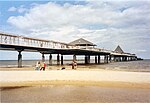Ahlbeck Pier
German building and structure stubsMecklenburg-VorpommernPiers in Germany

Ahlbeck Pier (German: Seebrücke Ahlbeck Polish: Molo w Czerninie) - a pier located in Ahlbeck, on the island of Usedom; it is the oldest pier in Germany. The pier stretches from the Imperial Beach for 280 metres into the Baltic Sea. The pier has a restaurant and a jetty at the end of the pier primarily used for sightseeing tours in the Bay of Pomerania.
Excerpt from the Wikipedia article Ahlbeck Pier (License: CC BY-SA 3.0, Authors, Images).Ahlbeck Pier
Seebrücke Ahlbeck,
Geographical coordinates (GPS) Address External links Nearby Places Show on map
Geographical coordinates (GPS)
| Latitude | Longitude |
|---|---|
| N 53.94412 ° | E 14.1927 ° |
Address
Seebrücke Ahlbeck
Seebrücke Ahlbeck
17419
Mecklenburg-Vorpommern, Germany
Open on Google Maps








